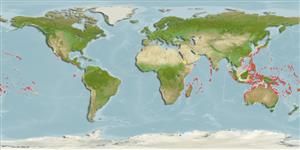Actinopterygii (ray-finned fishes) >
Perciformes (Perch-likes) >
Creediidae (Sandburrowers)
Etymology: Limnichthys: Greek,limne = swamp + Greek, ichthys = fish (Ref. 45335). More on author: Smith.
Environment / Climate / Range
Ecology
Marine; demersal; depth range 4 - 20 m (Ref. 90102). Tropical, preferred ?
Indo-Pacific: from east Africa and Red Sea to western Australia, Taiwan and Ogasawara Is., Micronesia, the Hawaiian Is., the Cook Is., and the Pitcairn group.
Size / Weight / Age
Maturity: Lm ? range ? - ? cm
Max length : 3.5 cm TL male/unsexed; (Ref. 5467)
Dorsal
spines
(total): 0;
Dorsal
soft rays
(total): 22-25;
Anal
spines: 0;
Anal
soft rays: 26 - 28. Body pale, with 8-12 narrow, short bars across dorsal surface (Ref. 5467). Dorsal saddles not reaching, even if present, a lateral band. Combined number of soft rays in dorsal and anal fins usually 44 to 51 (Ref 12874).
Benthic in surge-swept sand patches and shorelines (Ref. 1602, 58302). Found in sea bottoms with coarse sand and fine gravel 4-20 m deep (Ref. 90102). Occurs in small groups that bury themselves in coarse sand patches on reef corners subject to currents (Ref. 48636).
Life cycle and mating behavior
Maturity | Reproduction | Spawning | Eggs | Fecundity | Larvae
Nelson, J.S., 1986. Creediidae. p. 736-737. In M.M. Smith and P.C. Heemstra (eds.) Smiths' sea fishes. Springer-Verlag, Berlin. (Ref. 5467)
IUCN Red List Status (Ref. 115185)
CITES (Ref. 94142)
Not Evaluated
Threat to humans
Harmless
Human uses
More information
Common namesSynonymsMetabolismPredatorsEcotoxicologyReproductionMaturitySpawningFecundityEggsEgg development
ReferencesAquacultureAquaculture profileStrainsGeneticsAllele frequenciesHeritabilityDiseasesProcessingMass conversion
Tools
Special reports
Download XML
Internet sources
